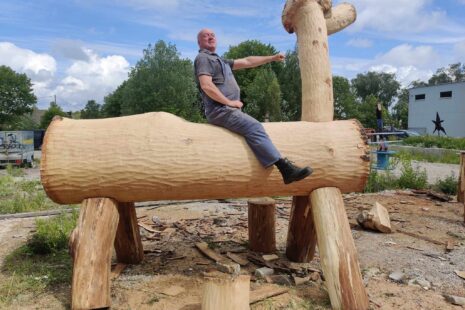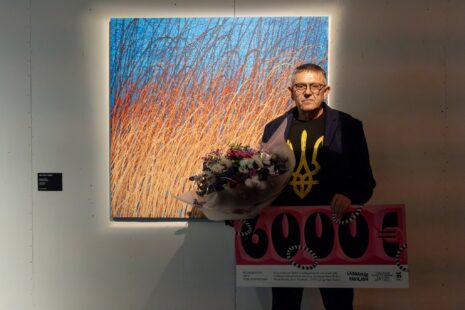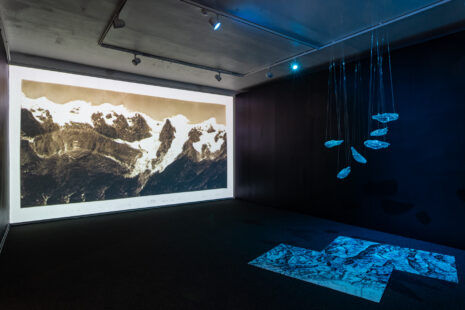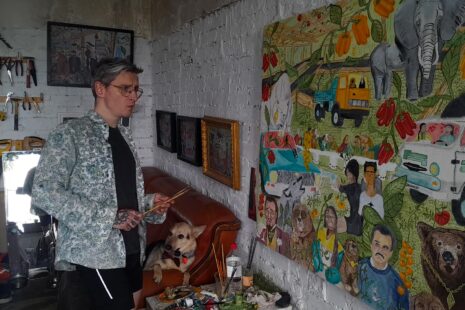To outline some key facts and figures related to the fair, June 2015 saw the sixth annual ArtVilnius held in the capital of Lithuania. This year, ArtVilnius presented 55 galleries from 15 countries of the world, spanning 12,000 square metres across the Lithuanian Exhibition and Congress Centre LITEXPO. The fair had 18.5 thousand visitors. More than 100 artworks were sold for 200 thousand euros and more than 1,600 foreign guests visited the fair.

Diana Stomiene, Director of ArtVilnius (Internet)
How would you position ArtVilnius among other big international art events? Given that there are so many other art fairs in the world, why should one definitely have visit/participate in ArtVilnius?
ArtVilnius is a young art fair that had its sixth edition this year. The fair originated in 2009, when Vilnius was named the cultural capital of Europe, and ArtVilnius’09 was one of the most important and one of the largest dedicated events.
The start of ArtVilnius was truly great and the fair becomes better known and grows in quality with every year. It has a load of possibilities for development and for becoming a leader in this region, since there is no other international art fair in a span of 1000 km around Lithuania that would reflect the art scene of the region. Baltic galleries and galleries from other neighbouring countries, taking part separately in such events as Vienna Fair, Art’15 in London, or in others, simply disappear, remain unseen and lose their identity.
The most famous art fairs have incredibly high entry fees (between EUR 5,000 and 15,000), galleries have a hard time to start operating at full strength, one needs to take part at least five years in a row in order to have some works bought, while ArtVilnius provides wonderful opportunities for its participants: a small fee (from EUR 1,000 to 2,000), good and stable architecture, comfortable arrangement of stands, good service, logistics, special business class events, great communication, etc. Foreign experts that have visited ArtVilnius emphasise that it does not emulate other art fairs.
Special attention in the ArtVilnius fair is paid to young galleries and artists: they are offered exclusive conditions (a preferential EUR 500 participation fee). During the course of the fair, we organise awards for the best galleries, artists, which are selected by an international jury. The artists and galleries that have been selected receive a huge amount of attention, offers. For example, Petras Lincevičius, a graduate from Vilnius Academy of Art, whose works are displayed at Vilnius Academy of Arts Exhibition Hall “Titanikas”, was nominated as the best young artist this year and received a financial prize established by Law Firm COBALT, maecenas of the art fair. All of the works by this artist were bought during the art fair and supplemented the collection of the Modern Art Centre, and that is not to mention huge international attention from the media that the winners enjoyed.
How important is the geographic aspect for ArtVilnius? Who and how makes decisions about which galleries/organisations are invited to participate in the fair?
I am the “founding mother” of art fair ArtVilnius, constantly working with the team on a strategy. We have gathered a public council for ArtVilnius and we invite professional art consultants. We have been visiting the most famous art fairs, biennales, observing the international art market and inviting galleries to take part. We also pay dedicated visits to certain countries to become acquainted with their gallerists, artists. For example, at the beginning of this year we were in Ukraine. We had seven best galleries here from Ukraine who won awards. We visited Poland in March, going from Krakow to Gdansk. Poland has been invited as a guest country to ArtVilnius’16 which will pay a special focus on the Polish art scene. In autumn, we will be announcing a contest for galleries and sending invitations. Then galleries will send their applications for the evaluation by an international committee or an invited artistic director.
When you select the galleries to be represented in the fair, is it important to get participants from certain countries or does the selection committee make its choices purely based on the artworks and profiles of the artists?
The largest attention is paid to the neighbouring countries and their quality art. Earlier, our main goal was to become an art crossroad between East and West, but when Russia began the war in Ukraine, the crossroad turned towards West, North and South. Of course, we are open to Russian art galleries and collectors, but the situation has changed completely.
I’d like to underline that we must unite and to establish a strong Central and Eastern European art block, because this allows more opportunities to attract attention from more art experts, collectors and visitors.
Who is the audience of ArtVilnius, who are the buyers – mostly local/regional or international?
ArtVilnius has international audience. Artworks have been bought by collectors from Germany, Denmark, Sweden, Norway, Finland, Japan, United States, Australia, Poland, Russia, Latvia, Ukraine, etc. We are happy to meet several foreign delegations of collectors every year. For example, this year a French delegation arrived in Vilnius by a private plane and bought several artworks.
A concept of “business and art synergy“ seems to hold an important place in the context of the fair – what does this mean in practice?
Special attention is given to business class partners and sponsors. For example, the Lewben Art Fondation established by the exclusive partner of the ArtVilnius’15, Lewben group, presented newly acquired artworks by world known artists and organised presentation of the art fair and their own collection for 200 most influential businessmen.
Why weren´t there any Estonian galleries in ArtVilnius 2015?
Temnikova & Kasela from Tallinn took part in the fair a few times. This year we sent out invitations to all of the main galleries in Estonia. Unfortunately, they did not respond or arrive. We are planning a visit to Estonia already this year to get personally acquainted with and invite the best galleries.
How has the fair developed over the years, what have been the main changes?
First, the fair’s programme has been extended. From 2014, we are presenting the projects of ArtVilnius in a separate exposition hall. Those projects are presentations of private collections and invited artists. The Lewben Art Foundation presented a part of the newly acquired collection by famous artists this year; also, there was audio and video installation “The Sixties” by world famous musician and artist Vladimir Tarasov, “Labyrinthus” by Dainius Liškevičius from Lithuania’s pavilion in Venice Biennale, and the project by Jonas Mekas Visual Arts Centre specially prepared for ArtVilnius.
The focus of ArtVilnius in 2014 was photography. The results have been felt: this year is successful for photography. There are many collectors and curators from abroad interested in Lithuania’s photography.
The biggest novelty this year is a guest country, and Ukraine became the first one. “Takas” is an exhibition of sculptures and installations that has been active from the first art fair, it has gained an international status as of this year, and 17 artists from Lithuania, Latvia, Ukraine, Russia and the South African Republic took part in it.
As of 2014, we are presenting collections of video art from foreign countries in the fair. This year we showed a programme of VIDEONALE (Germany), one of the oldest festivals for contemporary video art in Europe, which was presented in the fair by the creative director of the festival, Tasja Langenbach, and the program coordinator, Jenifer Gassman.
Can you please briefly describe the Lithuanian art market
The Lithuanian art market is sufficiently young, developing, which is similar to other countries that have recently gained their independence. Lithuanian national museums are buying very few pieces, so the biggest initiative is from private persons, who have also established the Lithuanian Modern Art Centre. The influence of private corporations is very important for the Lithuanian art market. An example of this would be the exclusive partner of ArtVIlnius’15, Lewben Art Foundation established by the Lewben Group, which is buying works of the best artists in Lithuania and abroad. An art auction has been held in Lithuania for 8 years and the numbers of works sold have been growing every year.
There are over 40 art galleries in Lithuania. A part of them (around 15 of them are actively selling art works) are private, while others are institutional ones, the Lithuanian Artists’ Association (7 galleries), Vilnius Academy of Arts (5 galleries), and municipal ones (focused more on international projects that are sponsored by the Lithuanian Council for Culture). Only five Lithuanian galleries are taking part in art fairs abroad. Each gallery in Lithuania works with artists individually, and there are both verbal, as well as written agreements. In the context of ArtVilnius, we are witnessing the improving situation of galleries which are gaining prestige. And artists become more responsible about working with galleries.
How do you see the cooperation of the Baltic states in the art sphere?
We are very keen to activate the art market of the Baltic region. I think, Estonia, Latvia and Lithuania could cooperate and become the main partners in ArtVilnius. We could achieve high-quality results together.
I believe that cooperation between Baltic countries in the art area must be maintained and strengthened, even though we truly are in close relationships with Latvian galleries. Participation in art fairs opens the way to a large amount of contacts and opportunities. Galleries are working together, exchange exhibitions, and make networks of contacts. To strengthen the cultural bond not only with the Baltic States, but also with countries that have a shared history with Lithuania, we are inviting a guest country from this year onwards.
This year it was Ukraine, next one will be Poland, and in 2018, the year of commemorating the 100th anniversary of independence, we will be inviting Latvia and Estonia. Cooperation gives us a chance to create a huge and bright art event with the best galleries, artists, projects.
No one ever did anything significant by sitting quietly and alone, and that is why I see the only solution – unity. Just like in the energy sector, for example, “Rail Baltica” between Helsinki and Warsaw, or development of other important economic projects
Who are your personal favourites in the art world?
Galleries White Cube, Gagosian, Lison, Hauser and Wirth. Artists Damien Hirst, Anish Kapoor, Jeff Koons, Sarah Lucas, Ai Wei Wei, Miroslaw Balka, and others.
As for Lithuanian artists, they are Jurgis Mačiūnas, Jonas Mekas, Žilvinas Kempinas, Antanas Sutkus, Algimantas Kunčius, Povilas Ričardas Vaitekūnas, Žilvinas Landzbergas, Donatas Jankauskas Duonis, and others.
What are the most important global art events in your opinion?
Art Fairs Frieze (United Kingdom), Arco Madrid (Spain), Art Basel (Switzerland, US, Hong Kong), Venice Biennale, Documenta Quadrennial (Germany), Manifesta, and many others.
Which are the media channels that you would recommend an art lover to follow to get a good overview of what is going on in the art world?
Arterritory, ArtFacts.net, ArtGuideEast, echogonewrong
Are there any Estonian artists that have caught your attention over the last few years?
Jaanus Samma, Merike Estna and Kaido Ole.
Author: Andra Orn
The inteview was published in Estonian cultural newspaper “Sirp”, 11.09.2015








